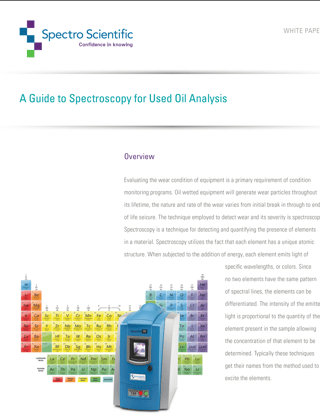 Evaluating the wear condition of equipment is a primary requirement of condition monitoring programs. Oil wetted equipment will generate wear particles throughout its lifetime, the nature and rate of the wear varies from initial break in through to end of life seizure. The technique employed to detect wear and its severity is spectroscopy. Spectroscopy is a technique for detecting and quantifying the presence of elements in a material. Spectroscopy utilizes the fact that each element has a unique atomic structure. When subjected to the addition of energy, each element emits light of specific wavelengths, or colors. Since no two elements have the same pattern of spectral lines, the elements can be differentiated. The intensity of the emitted light is proportional to the quantity of the element present in the sample allowing the concentration of that element to be determined. Typically these techniques get their names from the method used to excite the elements.
Evaluating the wear condition of equipment is a primary requirement of condition monitoring programs. Oil wetted equipment will generate wear particles throughout its lifetime, the nature and rate of the wear varies from initial break in through to end of life seizure. The technique employed to detect wear and its severity is spectroscopy. Spectroscopy is a technique for detecting and quantifying the presence of elements in a material. Spectroscopy utilizes the fact that each element has a unique atomic structure. When subjected to the addition of energy, each element emits light of specific wavelengths, or colors. Since no two elements have the same pattern of spectral lines, the elements can be differentiated. The intensity of the emitted light is proportional to the quantity of the element present in the sample allowing the concentration of that element to be determined. Typically these techniques get their names from the method used to excite the elements.

There are many approaches to measuring wear metals in oil and each has its advantages and limitations. Always determine the range of interest, the wear metals desired, volume of samples and resources available before considering what solution to investigate. Spectrometric oil analysis is applicable to any closed loop lubricating system, such as those found in diesel and gasoline engines, gas turbines, transmissions, gear boxes, compressors and hydraulic systems. In good practice, periodic oil samples are taken from the equipment being monitored. The spectrometer chosen needs to be able to analyze the sample for trace levels of metal worn from moving parts, as well as for extraneous contamination and additive element levels. The resulting data, when compared to previous analyses and allowable limits, may indicate a sound mechanism showing only normal wear, or it may point out a potentially serious problem in its early stages.
When considering a spectrometer to measure wear metals consider the following:
• The variety of elements, contaminants and additives sourced from the variety of
equipment and oils you are trying to measure.
• The ranges and performance of those elements you need to measure
• The number of samples you will need to test on a given day, month or year.
• The human resources you have available to maintain and operate the instrument
• The running costs and reliability over time
To learn more about used oil analysis click here


